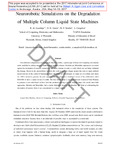Neurorobotic Simulations on the Degradation of Multiple Column Liquid State Machines
| dc.contributor.author | de Azambuja, R | |
| dc.contributor.author | Garcia, D | |
| dc.contributor.author | Stoelen, MF | |
| dc.contributor.author | Cangelosi, A | |
| dc.date.accessioned | 2017-05-14T22:19:47Z | |
| dc.date.available | 2017-05-14T22:19:47Z | |
| dc.date.issued | 2017-07-03 | |
| dc.identifier.isbn | 9781509061815 | |
| dc.identifier.issn | 2161-4393 | |
| dc.identifier.uri | http://hdl.handle.net/10026.1/9242 | |
| dc.description.abstract |
Two different configurations of Liquid State Machine (LSM), a special type of Reservoir Computing with internal nodes modelled as spiking neurons, implementing multiple columns (Modular and Monolithic approaches) are tested against the decimation of neurons, connections and entire columns in order to verify which one can better withstand the damage. Based on the neurorobotics outlook, this work is part of a bigger project that aims to apply artificial neural networks to the control of humanoid robots. Therefore, as a benchmark, we made use of a robotic task where an LSM is trained to generate the joint angles needed to command a simulated version of the collaborative robot BAXTER to draw a square on top of a table. The final drawn shape is analysed through Dynamical Time Warping to generate a cost value based on how close the produced drawing is to the original shape. Our results show both approaches, Modular and Monolithic, had a similar behaviour, however the Modular was better at withstanding the decimation of neurons when it was concentrated in a single column. | |
| dc.format.extent | 46-51 | |
| dc.language.iso | en | |
| dc.publisher | IEEE | |
| dc.subject | Liquid State Machine | |
| dc.subject | Reservoir Computing | |
| dc.subject | Robotics | |
| dc.subject | Graceful Degradation | |
| dc.subject | Neurorobotics | |
| dc.title | Neurorobotic Simulations on the Degradation of Multiple Column Liquid State Machines | |
| dc.type | conference | |
| dc.type | Proceedings Paper | |
| plymouth.date-start | 2017-05-14 | |
| plymouth.date-finish | 2017-05-19 | |
| plymouth.volume | 2017-May | |
| plymouth.conference-name | International Joint Conference on Neural Networks (IJCNN 2017) | |
| plymouth.publication-status | Published | |
| plymouth.journal | 2017 International Joint Conference on Neural Networks (IJCNN) | |
| dc.identifier.doi | 10.1109/ijcnn.2017.7965834 | |
| plymouth.organisational-group | /Plymouth | |
| plymouth.organisational-group | /Plymouth/Faculty of Science and Engineering | |
| plymouth.organisational-group | /Plymouth/REF 2021 Researchers by UoA | |
| plymouth.organisational-group | /Plymouth/REF 2021 Researchers by UoA/UoA11 Computer Science and Informatics | |
| plymouth.organisational-group | /Plymouth/Research Groups | |
| plymouth.organisational-group | /Plymouth/Research Groups/Institute of Health and Community | |
| plymouth.organisational-group | /Plymouth/Research Groups/Marine Institute | |
| dc.publisher.place | Anchorage, Alaska, USA | |
| dcterms.dateAccepted | 2017-02-04 | |
| dc.rights.embargoperiod | No embargo | |
| rioxxterms.funder | EPSRC | |
| rioxxterms.identifier.project | BABEL | |
| rioxxterms.versionofrecord | 10.1109/ijcnn.2017.7965834 | |
| rioxxterms.licenseref.uri | http://www.rioxx.net/licenses/all-rights-reserved | |
| rioxxterms.licenseref.startdate | 2017-07-03 | |
| rioxxterms.type | Conference Paper/Proceeding/Abstract | |
| plymouth.funder | BABEL::EPSRC |


